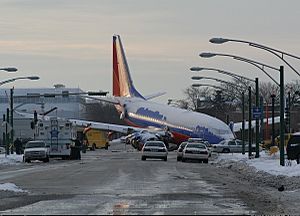Southwest Airlines Flight 1248 facts for kids
Southwest Airlines Flight 1248 was a passenger airplane trip from Baltimore to Chicago-Midway Airport. On December 8, 2005, the plane landed during a snowstorm. It slid off the end of the runway and onto a busy street. Sadly, a 6-year-old boy in a car on the street was killed. This was the first time a passenger died in an accident involving Southwest Airlines.
Contents
Understanding Flight 1248
This event taught important lessons about flying in bad weather. It showed how quickly things can go wrong. It also highlighted the need for strict safety rules. Airlines and airports work hard to prevent such accidents.
What Happened?
The flight was a regular trip. It started in Baltimore, Maryland. Its destination was Chicago, Illinois. The plane was a Boeing 737-700. This type of plane is very common. It carries many passengers every day.
The Flight and Landing
Flight 1248 took off from Baltimore without any problems. The flight itself was smooth. As the plane got closer to Chicago, the weather changed. A big snowstorm was hitting the area. This made landing very difficult.
The Runway Overrun
When the plane touched down, it was on Runway 31C. This runway is at Chicago Midway Airport. The pilots tried to slow the plane. But the runway was very slippery. It was covered in snow and ice. The plane could not stop in time. It slid past the end of the runway. It then crashed through a fence. The plane came to a stop on a nearby street. This street was called Central Avenue.
Why Did It Happen?
Accidents like this usually have several causes. Investigators look at everything. They check the weather, the plane, and what the pilots did. Their goal is to learn from the event. This helps prevent future accidents.
Weather Conditions
The main reason for the accident was the weather. A heavy snowstorm was happening. Visibility was low. The runway was covered in snow. This made it very hard for the plane to stop. Planes need good grip to brake safely.
Braking Challenges
The pilots tried to use the plane's brakes. They also used "reverse thrust." This is when the engines push air forward. It helps slow the plane down. But on the snowy runway, these methods were not enough. The plane kept sliding. It was moving too fast to stop before the end.
After the Accident
When the plane stopped, it was partly on the street. It had hit several cars. Emergency crews arrived very quickly. They helped the passengers and people on the street.
Immediate Response
Police, firefighters, and paramedics rushed to the scene. They helped passengers get off the plane. Many people on the plane had minor injuries. Sadly, a young boy in one of the cars was killed. This was a very tragic part of the accident.
The Investigation
The National Transportation Safety Board (NTSB) investigated the accident. They are a group that studies transportation accidents. They found that the snow and ice were key factors. They also looked at how the airport cleared runways. The NTSB makes recommendations. These help make flying safer for everyone.
Safety Changes
After the accident, airports and airlines reviewed their procedures. They looked at how they handle landings in bad weather. There were discussions about runway safety areas. These are extra spaces at the end of runways. They are designed to help stop planes that overrun. The plane involved in the accident was repaired. It was later put back into service.
Images for kids
-
ILS Runway 31C chart for Chicago Midway International Airport, where the incident occurred.
See also
 In Spanish: Vuelo 1248 de Southwest Airlines para niños
In Spanish: Vuelo 1248 de Southwest Airlines para niños




